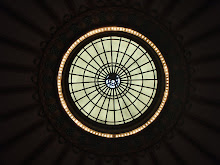
Even Skiffle Music relies on a solid bass line - enter the tea chest bass. I've been thinking about ways to add some bottom end to all the treble-y instruments I've been getting into lately. Followers of the Wellington International Ukulele Orchestra or the Ukulele Orchestra of Great Britain will notice that the bass is the only 'foreign instrument allowed in these groups.
Sourcing a tea chest was the hardest part of this project - they are by nature pretty flimsy - kind of the equivalent of those plywood cargo pallets that get smashed up. Like the cargo pallet, the tea chest has been largely replaced by plastic and other less resonant materials. So I was very lucky to find one from a friend, in pretty good shape and with some tea still floating around the cobwebs inside.
The construction was the easiest instrument making job so far - one broom handle, some pretty thick cord, a piece of dowel and a wooden rod - not quite a broom handle but close enough.
I followed this guys instructions and the whole thing took about 20 minutes (my tea chest is exactly the same as his! - strange). After a bit of playing with the cord length she was ready to go.
I have to say that the sound was much much better than I expected. I had spent some demoralising moments 'listening' to tea chest bass infused (note pun) music - basically it was impossible to hear behind the other instruments or sounded like a dull thud. Why would I want to make a tea chest bass that sounded no better than smacking cardboard? But I had an inkling that these instruments would be hard to record faithfully because of their low frequency range, and my tiny laptop speakers would not carry much bass at all.
It really does sound great, very booming but soft and thick, and loud enough to thicken a mix. You can kind of get some notes going as well which should improve with practice. And you don't need to look as uptight as me when you're playing it.

So what are these? Here, I am trying to put a glossary together for the record:best matcha powder perth
ReplyDelete